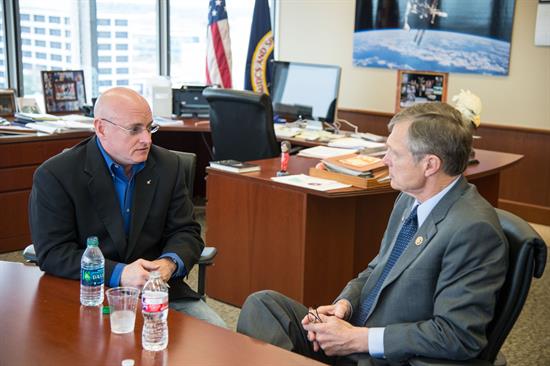Making space history
Washington,
April 4, 2015
Making space history
The Examiner By The Examiner Staff April 4, 2015 U.S. Representative Brian Babin, who represents Orange County, among others, in Texas District 36, met with NASA astronaut Scott Kelly of Orange, New Jersey, to wish him luck as he prepared to make history Friday, March 27, by embarking on a year-long mission to the International Space Station. Babin spoke on the House floor Thursday, March 26, regarding the importance of Kelly’s mission. “Mr. Speaker, I rise today to draw the American people’s attention to NASA Astronaut Scott Kelly as he prepares to make history,” Babin said. “As the proud representative of Johnson Space Center in Houston, Texas, I had the pleasure of meeting Mr. Kelly several times to discuss his historic mission. This will mark the first time an American has spent an entire year continuously in space. On the eve of this important moment, I’d like to thank Mr. Kelly for his heroic commitment, leadership and dedication to advancing America’s human space flight program.” Kelly and Russian Cosmonaut Mikhail Kornienko launched to the International Space Station Friday, March 27, beginning a one-year mission in space, testing the limits of human research, space exploration and the human spirit. Most expeditions to the space station last four to six months. By doubling the length of this mission, researchers hope to better understand how the human body reacts and adapts to long-duration spaceflight, a press release by NASA states. “This knowledge is critical as NASA looks toward human journeys deeper into the solar system, including to and from Mars, which could last 500 days or longer. It also carries potential benefits for humans here on Earth, from helping patients recover from long periods of bed rest to improving monitoring for people whose bodies are unable to fight infections,” the release states. There are seven key elements of research on the one-year mission, according to NASA. Functional studies will examine crewmember performance during and after the 12-month span. Behavioral studies will monitor sleep patterns and exercise routines. Visual impairment will be studied by measuring changes in pressure inside the human skull. Metabolic investigations will examine the immune system and effects of stress. Physical performance will be monitored through exercise examinations. Researchers will also monitor microbial changes in the crew, as well as the human factors associated with how the crew interacts aboard the station. While Scott Kelly is in space, his identical twin brother, retired NASA astronaut Mark Kelly, will participate in a number of comparative genetic studies, according to NASA. Some of these experiments will include the collection of blood samples as well as psychological and physical tests. These tests will track any degeneration or evolution that occurs in the human body from extended exposure to a zero-gravity environment. The new twin studies are a multi-faceted national cooperation between universities, corporations and government laboratory expertise. All research gathered from both the American and Russian crewmembers will be shared between the countries, an important step in reducing cost and improving efficiency for all future space station research. A number of spaceflight endurance records will be broken during the one-year mission, including the most cumulative time in space for any U.S. astronaut. Kelly will spend 342 days off the planet, resulting in a total of 522 days in space, allowing him to surpass current U.S. record holder Mike Fincke’s mark of 382 days. The current record for the longest single mission aboard the space station set by NASA astronaut Michael Lopez-Alegria and Russian cosmonaut Mikhail Tyurin will also be broken. Russian cosmonaut Gennady Padalka will launch with Kelly and Kornienko to remain aboard for six months and will become the new record holder for most cumulative time spent in space by any human. The one-year crew mission is the latest step in the International Space Station’s role as a platform for preparing humanity for exploration into deeper space. With the collaborative efforts of the international crew and research teams, the world can watch and benefit from findings that are pushing the boundaries of exploration while contributing to human health. |

